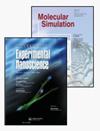Effect of twin boundary spacing on the mechanical properties of nano-columnar crystalline Cu-Ni alloy
IF 2
4区 化学
Q4 CHEMISTRY, PHYSICAL
引用次数: 0
Abstract
ABSTRACTNanotwinned exist in crystals as coherent interfaces with low interfacial energy, which can not only improve the strength of metal materials, but also increase the ductility. In this manuscript, we have performed molecular dynamics simulations of the mechanical properties of a nano-columnar crystalline Cu-Ni alloy with different twin boundary spacing. It is found that the model without twin has a stacking fault tetrahedron composed of stair-rod dislocations, which results in a small change in dislocation density at the later stage of deformation, and the average stress after yielding is lower than that of the model with twin. During the deformation process, with the increase of Other atoms, the dislocation slip barrier is enhanced, the tensile strength is increased, and the yield phenomenon is delayed, which is more obvious with the decrease of twin boundary spacing. The dislocation density decreases with the decrease of the spacing of the twin boundary, and the dislocation segments become shorter. When the twin boundary spacing is 0.625 nm, the tensile strength is increased by about 71% compared with the model without twin structure.KEYWORDS: Nanotwinnedmechanical propertiesmolecular dynamicsCu-Ni alloy Disclosure statementThe authors declare that they have no known competing financial interests or personal relationships that could have appeared to influence the work reported in this paper.Additional informationFundingThe work was supported by Local Science and Technology Development Fund Projects Guided by the Central Government of China (grant number 23ZYQB300), the National Key R&D Program of China (grant numbers 2017YFA0700701, 2017YFA0700703), National Natural Science Foundation of China (grant number 52061025), Key Research Program of Education Department of Gansu Province (grant number GSSYLXM-03).孪晶界距对纳米柱状Cu-Ni合金力学性能的影响
摘要纳米孪晶以低界面能的共调界面形式存在于晶体中,不仅可以提高金属材料的强度,还可以提高材料的延展性。在本文中,我们对具有不同孪晶边界间距的纳米柱状Cu-Ni合金的力学性能进行了分子动力学模拟。结果表明:无孪晶模型存在一个由阶梯位错组成的层错四面体,变形后期位错密度变化较小,屈服后的平均应力低于有孪晶模型。变形过程中,随着其他原子数量的增加,位错滑移障垒增强,拉伸强度提高,屈服现象延迟,且随孪晶边界间距的减小更为明显。位错密度随孪晶界间距的减小而减小,位错段变短。当孪晶边界间距为0.625 nm时,与不含孪晶结构的模型相比,拉伸强度提高了约71%。关键词:纳米双晶力学性能分子动力学cu - ni合金披露声明作者声明,他们没有已知的竞争经济利益或个人关系可能会影响本文所报道的工作。项目资助:中央政府地方科技发展基金项目(批准号23ZYQB300)、国家重点研发计划项目(批准号2017YFA0700701、2017YFA0700703)、国家自然科学基金项目(批准号52061025)、甘肃省教育厅重点研究计划项目(批准号GSSYLXM-03)。
本文章由计算机程序翻译,如有差异,请以英文原文为准。
求助全文
约1分钟内获得全文
求助全文
来源期刊

Molecular Simulation
化学-物理:原子、分子和化学物理
CiteScore
3.80
自引率
9.50%
发文量
128
审稿时长
3.1 months
期刊介绍:
Molecular Simulation covers all aspects of research related to, or of importance to, molecular modelling and simulation.
Molecular Simulation brings together the most significant papers concerned with applications of simulation methods, and original contributions to the development of simulation methodology from biology, biochemistry, chemistry, engineering, materials science, medicine and physics.
The aim is to provide a forum in which cross fertilization between application areas, methodologies, disciplines, as well as academic and industrial researchers can take place and new developments can be encouraged.
Molecular Simulation is of interest to all researchers using or developing simulation methods based on statistical mechanics/quantum mechanics. This includes molecular dynamics (MD, AIMD), Monte Carlo, ab initio methods related to simulation, multiscale and coarse graining methods.
 求助内容:
求助内容: 应助结果提醒方式:
应助结果提醒方式:


